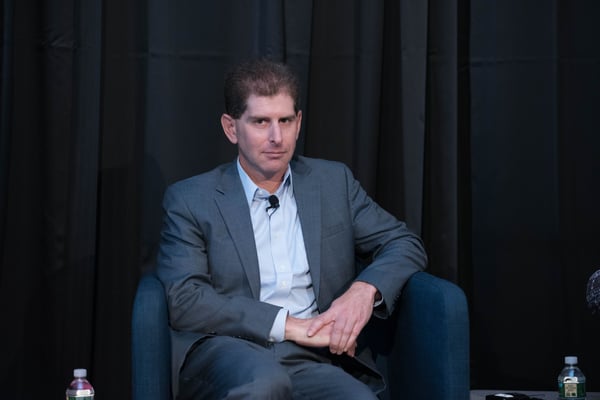Over 1.25 million people globally die in road related incidences: which should be considered a major undertreated public health crisis. Looking at road fatalities in particular, 90% of road fatalities are related to some form of human error. This demonstrates a serious need to understand much more deeply how humans make poor decisions and the need to encourage more strategic behavior over time.
In our latest Affectiva Asks podcast, Affectiva's CMO and Head of Product Strategy, Gabi Zijderveld, interviews Bryan Reimer. Bryan is a Research Scientist at MIT AgeLab & Associate Director of the New England University Transportation Center. Bryan is a thought leader in driver safety and the future of mobility.
During their interview, he talks to us a bit about his work at MIT, some of the challenges of AI in automotive and how OEMs and Tier 1s can overcome them.

Let's start by having you tell us a bit about your work at MIT. And especially areas of your work that touch on Automotive.
Sure, I've been looking at, really driver behavior and how we behave in cars for a little over 20 years now. In watching evolution of what we touch, what we do with increasing levels of automations surrounding the driver for nearly two decades. In the team that I have at MIT, really spans the gamut, from the basics of experimental psychology, human factors, policy all the way over to really advanced AI. Try to fuse together different disciplines, understand really the future of mobility, how drivers behaving, well, optimally, not as effectively as we may want at times, may transform from those with hands on the wheel, foot on the gas pedal and the brake, to long-term becoming riders in a mobility system, over the course of decades.
Is there perhaps an example you can give us with where they're systems that are failing today and what might be ways that we could improve them?
I wouldn’t say that systems are failing: I think the systems are not being used to their full potential. When we look at technologies in cars, such as collision warnings, light departure warnings, or even voice systems, a lot of these technologies are designed to enhance the experience and improve safety. But yet we don't come equipped with all the skills to leverage them. Voice interactions are a great example. As individuals get more frustrated, whether it's with the smartphone, or the car, with the system not recognizing them, you can hear the frustration in their voice. And that further decreases the ability to recognize the signal. So the harder it is for us to communicate, the poorer performance in the voice recognition systems. Which only amplifies frustration and causes many of us to become less reliant on technologies that can help make life much easier.
In the context of driver safety, we're seeing more driver monitoring systems coming to market. That's an area that Affectiva's technology is being applied to: tell us a bit about your thoughts on the systems and where they stand today, and where you see this area of technology evolving in the future.
The area of driver monitoring is an area I've been working on for the best part of 20 years, and I am a staunch advocate for standardization and driver monitoring systems across the industry for the basics of distraction estimation and support, as well through to the levels of automation. But the key here for driver monitoring is the enabling technology that allows us to invest much deeper in helping drivers manage their attentional flow and responsibilities to the road.
We used to think that the negative aspects of distraction and attention were all about looking away from the road. In our recent work, we realized it also comes to the strategic allocation of attention to the road. So if we don't look up at the road for long enough, we don't acquire the situational information we need to make good decisions. And for a while we thought looking at the road just briefly allowed us to restore that information. But it doesn't: you have to look up for a few seconds to require the information of what is going on around you.
As drivers, we are so focused on what we want to get done, that we don't make the time available to look up. Driver monitoring allows drivers to manage their attention more effectively over time. Most importantly, as we begin to infuse more automation into the vehicle and drivers are copacetic with allowing their attention to wane into different activities, and the manufacturers of these systems encouraging that (because why would you automate if we're not allowed to do other things?)
Driver monitoring becomes the key safety technology that allows us to leverage driver skill in areas where the automation is not going to be strong. Future automotive systems are either going to be highly robotic, no onboard driver, tele-operated most likely, or systems that leverage the combined capacity of the driver with that of AI to enhance safety beyond the drivers or AI can do alone, in situations that are less predictable.
So we need to remember, machines are good at black and white types of decisions. Keeping the car in the lane, when there are lane markings on the road. Humans on the other hand, are much better working in the gray area - like driving down that road where there are no lane lines. Driver monitoring is the glue that begins to hold human expertise with machine expertise together.
When you think of the future of more automated and more autonomous vehicles, how can the automotive industry build the trust that's necessary to really accelerate consumer adoption?
I think trust is built over time, and eroded quickly. There are a couple of key points when we think about developing this trust in AI and the future of mobility. First of all, this is an evolution of robots on our roads, not a revolution. It is going to take decades to really transform how we live and move through automation.
For the last few years, we have been fueled by an AI hype cycle that is over-promised and under-delivered. We approaching 2020, when a number of vehicle manufacturers had long promised that we would be seeing robo-taxis and other AI-fueled driving technologies on the roads. We, as humans, are exceptional at visualizing the future: but we are pretty poor at the timeline to that. So when we look towards developing these systems, we need to level the playing field and begin to talk about realistic time frames. We also need to set expectations to align with the likely technology trajectory. Under-promising and over-delivering is likely to enhance trust more effectively.
Second, we need to look at the building blocks of trust in vehicles, and the technologies that fuel this are here today, in the form of partially automated driving. The experiences we gain with those systems are going to set a base level of trust with the technology in cars that's going to carry forward into the future of autonomy. We see in some of our data at MIT that those who are more comfortable with advanced driver assistance systems today are much more comfortable with the context of automation tomorrow. So, how do we get people to begin to trust the technology that's in their car today? We need to do a better job of delivering technology people are leveraging the fullest extent.
What are some of the lessons for OEMs and Tier 1s, and what they should do to actually achieve that?
One of the key lessons comes from Honda. This is a company I've always been fascinated with: it seems to under-promise and over-deliver more frequently in their technology packages, vehicles, sales and marketing practices than other manufacturers. So when your expectations are set low and the technologies perform above that, our perceptions of the future are much brighter.
I know that's very contrary to how marketing wants to work, but if we want to build trust, we need to be excited and delighted beyond expectations. When we want to compete at the marketing of technologies, we try to inflate expectations to a higher degree. I think this is a very difficult point for this industry as it moves forward in a very critical moment, from an industry that has its roots in powertrain and bending sheet metal to an industry that's going to be fueled by electronics and software. The future is where our ability to change the experience in the vehicle will be at the flip of a switch or at the download of an update is going to be feasible. But if we change things before we understand what's going on around us, or move things from a mental model that aren't familiar with, our trust in a technology will wane. Expectations are key to enhancing trust.






